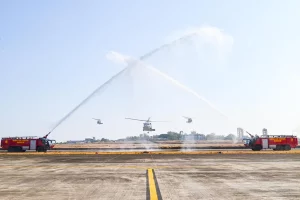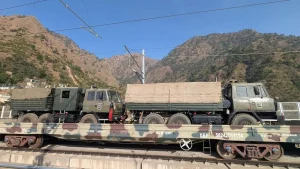The Indian Armed Forces have been undergoing significant modernization and enhancement of their capabilities, ensuring that they remain at the cutting edge of technology and preparedness. The year 2024 has seen the induction of several major defence equipments and pivotal defence deals that will bolster India’s strategic and tactical strength. Here, we explore some of the key inductions and agreements that are shaping the future of India’s defence landscape.
AFCAT 1 2024 Induction of Major Defence Equipments & Defence Deals
1. Agni-Prime Ballistic Missile
The Strategic Forces Command (SFC) successfully conducted the flight-test of the Agni-Prime, a new generation ballistic missile. This missile is part of India’s credible minimum deterrence posture and is designed to strike targets at a range of up to 2,000 kilometers with high precision. The Agni-Prime is lighter and has improved accuracy and performance over its predecessors, making it a critical component of India’s nuclear triad.
2. Akashteer Command and Control System
The Indian Army has inducted the Akashteer Command and Control Systems into its Corps of Army Air Defence. This system enhances the Army’s capability to detect, track, and neutralize aerial threats, thereby significantly boosting India’s air defence network. The Akashteer system is an indigenous development by the Defence Research and Development Organisation (DRDO) and showcases India’s growing self-reliance in defence technology.
3. P-8I Maritime Patrol Aircraft
The Indian Navy’s maritime capabilities have been augmented with the addition of more P-8I aircraft. These long-range, multi-mission maritime patrol aircraft are equipped with advanced sensors and weapons systems, capable of anti-submarine warfare, anti-surface warfare, and intelligence, surveillance, and reconnaissance (ISR) missions. The P-8I fleet plays a vital role in securing India’s maritime interests, particularly in the Indian Ocean Region.
4. Hexacopter Drone Innovation
The Indian Army has introduced hexacopter drones designed for high-altitude operations. These drones provide critical real-time surveillance and reconnaissance capabilities, enhancing the operational efficiency of troops in challenging terrains such as the Himalayan region. The indigenously developed drones reflect India’s focus on leveraging advanced technologies for operational superiority.
5. BHISHM Portable Cubes
The Indian Air Force (IAF) has tested the BHISHM portable cubes, a revolutionary innovation in field communication systems. These portable units ensure seamless communication across various platforms and terrains, thus improving coordination and operational effectiveness in joint operations. The BHISHM cubes are part of the IAF’s modernization efforts to incorporate cutting-edge technology in its operational framework.
Major Defence Deals
1. India-Russia Defence Agreements
India has signed several key defence deals with Russia, continuing the long-standing strategic partnership between the two nations. These deals include the procurement of additional S-400 Triumf air defence systems, enhancing India’s airspace security against aerial threats. Additionally, agreements for the acquisition and localized production of advanced fighter jets and helicopters have been finalized, contributing to the modernization of India’s air and land forces.
2. India-US Defence Collaboration
The bilateral defence cooperation between India and the United States has seen significant progress with new agreements focusing on technology transfer and co-development of advanced defence systems. Notably, the deal for the supply of MQ-9B SeaGuardian drones to the Indian Navy aims to bolster maritime surveillance capabilities. Furthermore, initiatives under the Defence Technology and Trade Initiative (DTTI) aim to enhance joint production and research in critical technologies.
3. India-France Rafale Deal Extension
Following the successful induction of the first batch of Rafale fighter jets, India has extended its agreement with France to procure additional units. These multi-role fighter jets are equipped with state-of-the-art avionics, weaponry, and advanced radar systems, significantly enhancing the combat capabilities of the Indian Air Force. The Rafale deal also includes a focus on technology transfer and support for local manufacturing under the Make in India initiative.
4. India-Israel Defence Cooperation
India and Israel continue to deepen their defence cooperation with new agreements focusing on advanced weaponry and surveillance systems. Key deals include the procurement of advanced surface-to-air missile systems and loitering munitions, which will enhance India’s precision strike capabilities. Collaborative efforts in cyber defence and counter-terrorism are also pivotal components of this strategic partnership.
Conclusion
The induction of these major defence equipments and the signing of significant defence deals underscore India’s commitment to modernizing its armed forces and enhancing its strategic capabilities. These advancements not only fortify India’s defence posture but also contribute to regional stability and security. As the Indian Armed Forces continue to evolve, the nation stands prepared to face emerging threats and challenges with confidence and technological superiority.




















